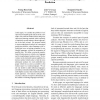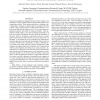133
Voted
EMNLP
2011
14 years 8 days ago
2011
In this paper, we consider the problem of unsupervised morphological analysis from a new angle. Past work has endeavored to design unsupervised learning methods which explicitly o...
154
click to vote
ACL
2011
14 years 4 months ago
2011
We present a pointwise approach to Japanese morphological analysis (MA) that ignores structure information during learning and tagging. Despite the lack of structure, it is able t...
141
click to vote
ICASSP
2011
IEEE
14 years 4 months ago
2011
IEEE
Korean is an agglutinative language that does not have explicit word boundaries. It is also a highly inflective language that exhibits severe coarticulation effects. These charac...
105
Voted
IAJIT
2011
14 years 7 months ago
2011
In this paper, we present an Arabic morphological analysis system that assigns, for each word of an unvoweled Arabic sentence, a unique root depending on the context. The proposed...
96
Voted
COLING
2010
14 years 7 months ago
2010
Because English is a low morphology language, current statistical parsers tend to ignore morphology and accept some level of redundancy. This paper investigates how costly such re...
103
Voted
NLE
2008
15 years 14 days ago
2008
Morphological analysis is a crucial component of several natural language processing tasks, especially for languages with a highly productive morphology, where stipulating a full ...
97
Voted
CORR
2010
Springer
15 years 19 days ago
2010
Springer
We are developing electronic dictionaries and transducers for the automatic processing of the Albanian Language. We will analyze the words inside a linear segment of text. We will...
91
Voted
ANLP
2000
15 years 1 months ago
2000
This paper proposes a framework of language independent morphological analysis and mainly concentrate on tokenization, the first process of morphological analysis. Although tokeni...
NAACL
2003
15 years 1 months ago
2003
Named Entity (NE) extraction is an important subtask of document processing such as information extraction and question answering. A typical method used for NE extraction of Japan...
CLEF
2008
Springer
15 years 2 months ago
2008
Springer
Many modern natural language processing applications would benefit from automatic morphological analysis of words, especially when dealing with morphologically rich languages. Con...



